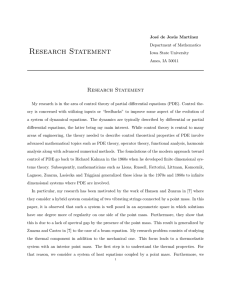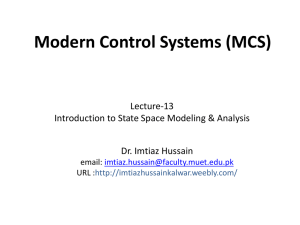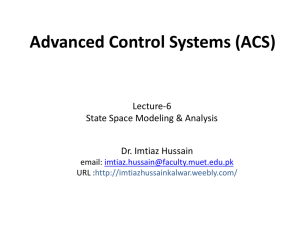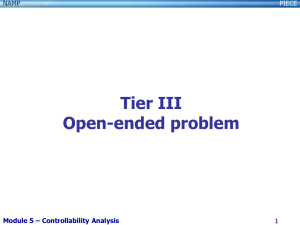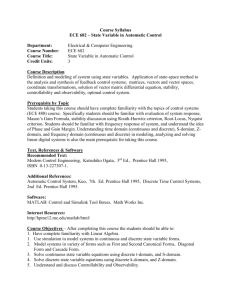NULL CONTROLLABILITY OF A THERMOELASTIC PLATE
advertisement
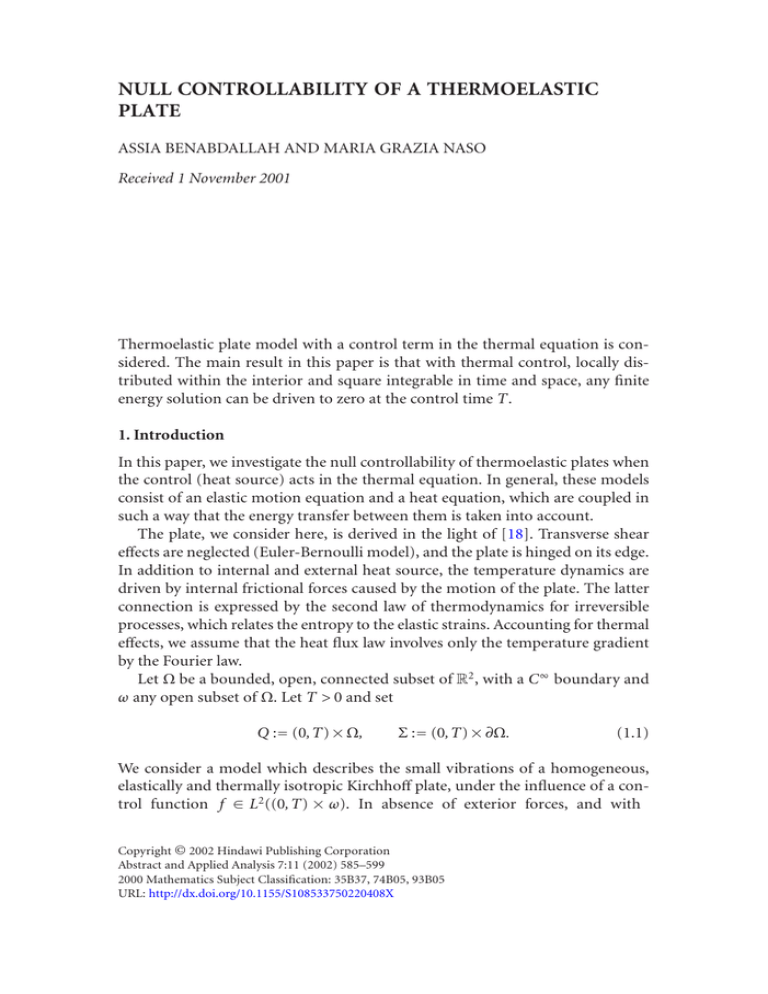
NULL CONTROLLABILITY OF A THERMOELASTIC PLATE ASSIA BENABDALLAH AND MARIA GRAZIA NASO Received 1 November 2001 Thermoelastic plate model with a control term in the thermal equation is considered. The main result in this paper is that with thermal control, locally distributed within the interior and square integrable in time and space, any finite energy solution can be driven to zero at the control time T. 1. Introduction In this paper, we investigate the null controllability of thermoelastic plates when the control (heat source) acts in the thermal equation. In general, these models consist of an elastic motion equation and a heat equation, which are coupled in such a way that the energy transfer between them is taken into account. The plate, we consider here, is derived in the light of [18]. Transverse shear effects are neglected (Euler-Bernoulli model), and the plate is hinged on its edge. In addition to internal and external heat source, the temperature dynamics are driven by internal frictional forces caused by the motion of the plate. The latter connection is expressed by the second law of thermodynamics for irreversible processes, which relates the entropy to the elastic strains. Accounting for thermal effects, we assume that the heat flux law involves only the temperature gradient by the Fourier law. Let Ω be a bounded, open, connected subset of R2 , with a C ∞ boundary and ω any open subset of Ω. Let T > 0 and set Q := (0,T) × Ω, Σ := (0,T) × ∂Ω. (1.1) We consider a model which describes the small vibrations of a homogeneous, elastically and thermally isotropic Kirchhoff plate, under the influence of a control function f ∈ L2 ((0,T) × ω). In absence of exterior forces, and with Copyright © 2002 Hindawi Publishing Corporation Abstract and Applied Analysis 7:11 (2002) 585–599 2000 Mathematics Subject Classification: 35B37, 74B05, 93B05 URL: http://dx.doi.org/10.1155/S108533750220408X 586 Null controllability of a thermoelastic plate hinged mechanical and Dirichlet thermal boundary conditions, the system we are going to study is the following one: utt + ∆2 u + ∆θ = 0 in Q, θt − ∆θ − ∆ut = f in Q, u = ∆u = 0 on Σ, (1.2) θ = 0 on Σ, u(0) = u0 , ut (0) = u1 , θ(0) = θ 0 on Ω. Here, u is the vertical deflection of the plate and θ is the variation of temperature of the plate with respect to its reference temperature. The subscript ·t denotes time derivative, and u0 , u1 , θ 0 are initial data in a suitable space. We recall (cf. [20, 26]) that a system is exactly controllable at given time T > 0 if it can be driven from any state to any state belonging to the same space of states where the system evolves. A system is null controllable at time T > 0 if an arbitrary state can be transferred to 0 in time T, or equivalently, any state can be joined to any trajectory (e.g., attainability of the trajectories). The null controllability does not yield the exact controllability of the system (cf. the heat equation with distributed control in the domain Ω [26]). In recent years, many efforts have been devoted to studying the controllability of thermoelastic systems, under varying boundary conditions, and with different choices of control on the boundary or in the control domain. In the classical literature some controllability results are established. Haraux [15] studies the internal controllability of a rectangular plate Ω in R2 . By denoting with ω the set Ω ∩ B = ∅, where B is an open strip parallel to one side of Ω, he proves that for any T > 0 and any (y0 , y1 ) ∈ (H 2 (Ω) ∩ H01 (Ω)) × L2 (Ω), there exists a control h ∈ L2 ((0,T) × Ω) with supph ⊂ (0,T) × ω such that the solution of ytt + ∆2 y = h in Q, y = ∆y = 0 on Σ, y(0) = y0 , yt (0) = y1 (1.3) on Ω satisfies (y(T), yt (T)) = (0,0) (or equivalently, the null controllability at any time T > 0). Lasiecka and Triggiani [21] show the null controllability at any time T > 0 of the thermoelastic plate equation with hinged mechanical and Dirichlet thermal boundary conditions, under the influence of either mechanical or thermal A. Benabdallah and M. G. Naso 587 control on the whole domain, namely utt + A2 u − Aθ = f1 in Q, θt + Aθ + Aut = f2 in Q, u = Au = 0 on Σ, (1.4) θ = 0 on Σ, u(0) = u0 , ut (0) = u1 , θ(0) = θ 0 on Ω, where A is a strictly positive, selfadjoint partial differential operator with compact resolvent, and ( f1 , f2 ) = (0,h) or ( f1 , f2 ) = (k,0), with h,k ∈ L2 ((0,T) × Ω) and h,k ≡ 0. On the other hand, by considering in addition the rotatory inertia in the plate motion equation, Avalos [5] complements the previous result. He proves the exact controllability at any time T > 0 for thermoelastic system utt − γ∆utt + ∆2 u + α∆θ = f1 θt − ∆θ + σθ − α∆ut = f2 in Q, in Q, ∂u = 0 on Σ, ∂ν θ = 0 on Σ, u= u(0) = u0 , ut (0) = u1 , θ(0) = θ 0 (1.5) on Ω in absence of control forces ( f1 ≡ 0), with a control f2 ∈ L2 (0,T;H −1 (Ω)) in the whole Ω. The choice of this control space yields the result of exact controllability. De Teresa and Zuazua [10] consider the thermoelastic plate system (1.5) in presence of a control function f1 ∈ L1 (0,T;H −1 (Ω)), with supp f1 (·,t) ⊂ ω ⊂ Ω, in absence of heat sources ( f2 ≡ 0), and with σ ≡ 0 and γ = 0. Clamped boundary conditions are imposed on u. By using a decoupling result (see [16]) for three-dimensional thermoelasticity, a variational approach to controllability (see [13]), and some observability inequalities for the system of thermoelastic plate, a result of exact-approximate controllability is obtained. More precisely, they prove the exact controllability of the displacement and the approximate controllability of the temperature, when the control time T is large enough and the support ω of the control satisfies the geometric control conditions introduced in [8]. In other words, they find sufficient conditions on control time T and control region ω such that for every initial and final data (u0 ,u1 ,θ 0 ), (v0 ,v1 ,ξ 0 ), belonging to the space of states where system (1.5) evolves, and for every ε > 0 there exists a control function f1 such that the solution of (1.5) satisfies u(T) = v0 , ut (T) = v1 , θ(T) − ξ 0 L2 (Ω) ≤ ε. (1.6) 588 Null controllability of a thermoelastic plate Finally, we want to recall an important contribution by Lebeau and Zuazua [24] to the controllability theory of thermoelastic systems. By using the spectral decomposition of operators generated by the coupled wave and heat equations state variables, Lebeau and Zuazua study the null controllability at any time T > 0, when the control acts in the wave equation part as distributed control. They suppose the geometric control condition for the wave equation in the domain. With the same assumptions they also prove that the null controllability at any time T > 0 holds when the control acts on the heat equation. Instead of an interior control implemented in the motion or in the heat equation, if the control time T is sufficiently large, Lagnese [19] gives the exact controllability of the displacement, for a boundary controlled thermoelastic system. In this work, free boundary conditions are imposed, instead of the clamped ones in (1.5). Moreover, constant γ is positive and coupling constant α is small enough. By considering the same previous thermoelastic system, and inserting additional thermal control on an arbitrarily small subset of the boundary, Avalos and Lasiecka [6, 7] dispense with the smallness assumption on α, and they tackle the exact-approximate controllability of thermoelastic plates with variable coupling coefficient of thermal expansion α, respectively. Finally, we recall a recent paper of Eller et al. [11] where they study the exact-approximate boundary controllability of thermoelastic plates with thermal coefficient variable in space. The null controllability problem for the heat equation has been developed recently by Carleman estimates [12, 14]. This result enables to study the nonlinear case with variable coefficients, and to apply Carleman estimates to thermoelastic plate. In particular, if T is sufficiently large, Albano and Tataru [2] prove some Carleman estimates for a coupled parabolic-hyperbolic system. They obtain a boundary observability estimate which, by duality, implies the null controllability for the adjoint system. Instead of the wave operator, Albano [1] gets a similar result in the case of the plate operator. In this paper, we present the null controllability at any time T > 0 for thermoelastic problem (1.2). We consider an interior control applied in the heat equation, and supported in a subset ω of the domain Ω. Two results are obtained. Firstly, we study the case when ω ≡ Ω and we find the null controllability at any time T > 0, as Lasiecka and Triggiani [21]. Our procedure is supported by introducing a quadratic function depending on the time (see [4]). Multipliers method is applied to construct this function [3, 5, 6]. Then, we consider the case when ω Ω, and the closure of ω does not intersect the boundary of Ω. By applying an iterative method and the observability estimates on the eigenfunctions of the Laplacian operator due to Lebeau and Robbiano [23] (see also [24]), we show that system (1.2) is null controllable at any time T > 0. In our proof, the analyticity property of semigroup associated to the thermoelastic system (recall γ = 0, see Lasiecka and Triggiani [22]), and the commutative property of the operators, which comes from the hinged boundary conditions, are crucial. A. Benabdallah and M. G. Naso 589 The paper is organized as follows. Section 2 is devoted to functional setting and notation. In Section 3, we study the case ω ≡ Ω. In particular, we prove the null controllability of system (1.2) by a control supported in the whole domain. Finally, Section 4 contains the main result of this paper. 2. Functional setting and notation We introduce the Hilbert space H := H 2 (Ω) ∩ H01 (Ω) × L2 (Ω) × L2 (Ω) (2.1) equipped with the inner product z1 ,z2 H = Ω ∆u1 · ∆u2 + v1 · v2 + θ1 · θ2 dx, (2.2) where ui zi = vi , θi i = 1,2. (2.3) The induced norm is denoted by · H . Putting v = ut and u0 z0 = v0 , θ0 u(t) z(t) = v(t) , θ(t) (2.4) problem (1.2) can be rewritten as an abstract linear evolution equation in H of the form zt = Az + B f , z(0) = z0 ∈ H, (2.5) where we set the operator A : D(A) → H by 0 A = −∆2 0 I 0 0 −∆ ∆ ∆ (2.6) with domain D(A) = z ∈ H : ∆u,v,θ ∈ H 2 (Ω) ∩ H01 (Ω) , (2.7) and the control operator B : L2 (ω) → H by 0 B f = 0 . f (2.8) 590 Null controllability of a thermoelastic plate Given T > 0, the problem of the null controllability of system (2.5) consists in to prove that, for any z0 ∈ H, there exists a control f ∈ L2 ((0,T) × ω) such that the solution z(t;z0 , f ) of (2.5) satisfies z(T;z0 , f ) = 0. This property is equivalent to (cf. [26, Theorem 2.6, page 213]): there exists a positive constant CT such that A∗ T 0 2 e y H ≤ CT T ∗ A∗ t 0 2 B e y 2 ∀ y 0 ∈ H. L (ω) dt, 0 (2.9) We compute −I 0 A∗ = ∆2 0 0 0 ∆ −∆ ∆ (2.10) with domain D(A∗ ) = D(A), and B∗ = [0 0 I]. (2.11) The adjoint system with respect to (1.2) is ϕtt + ∆2 ϕ + ∆w = 0 in Q, wt − ∆w − ∆ϕt = 0 ϕ = ∆ϕ = 0 in Q, on Σ, (2.12) w = 0 on Σ, 0 ϕt (0) = ϕ1 , ϕ(0) = ϕ , w(0) = w0 on Ω. Its solution can be written as ϕ(t) ϕ0 ∗ ϕt (t) = eA t ϕ1 , w0 w(t) (2.13) ϕ0 ∗ A∗ t 1 B e ϕ = w(t). w0 (2.14) Then, condition (2.9) is equivalent to require that there exists a positive constant CT such that ∆ϕ(T)2 2 L (Ω) 2 + ϕt (T) 2 L (Ω) 2 + w(T) 2 for any solution (2.13) of system (2.12). L (Ω) ≤ CT T 0 w(t)2 2 L (ω) dt (2.15) A. Benabdallah and M. G. Naso 591 3. Null controllability when ω ≡ Ω We have the following result. Theorem 3.1. For any T > 0 and for any z0 ∈ H, there exists a control function f ∈ L2 ((0,T) × Ω) such that the solution z(T;z0 , f ) of (2.5) satisfies z(T;z0 , f ) = 0. That is to say, problem (2.5) is null controllable in arbitrary time T > 0 on the space H within the class of L2 ((0,T) × Ω)-controls. Remark 3.2. By a different method, Lasiecka and Triggiani [21] show the previous result. Proof. In Section 2 we recalled that the request of null controllability is equivalent to: there exists a positive constant CT such that ∆ϕ(T)2 2 2 2 L (Ω) + ϕt (T) L2 (Ω) + w(T) L2 (Ω) ≤ CT T 0 w(t)2 2 L (Ω) dt (3.1) ϕ(t) for any solution of system (2.12). Let responding to an initial data Ᏻ(t) = ϕ0 ϕ1 w0 ϕt (t) w(t) be a solution of system (2.12) cor- ∈ D(A∗ ) = D(A). We introduce the function t 5 ∆ϕ(t)2 2 + ϕt (t)2 2 + w(t)2 2 L (Ω) L (Ω) L (Ω) 2 3 −1 4 + αt w(t),(−∆) ϕt (t) L2 (Ω) + βt ϕ(t),ϕt (t) L2 (Ω) + 4βt 3 (−∆)−1 w(t),ϕ(t) L2 (Ω) + γt 3 2 (−∆)−1/2 w(t)L2 (Ω) (3.2) 2 + δt 4 (−∆)−2 wt (t)L2 (Ω) − 2δt 4 (−∆)−1 ϕ(t),w(t) L2 (Ω) 2 + δt 4 (−∆)−1 w(t)L2 (Ω) , where α, β, γ, and δ are positive constants that will be chosen later. By a differentiation of Ᏻ(t) with respect to t and by application of Young inequality, we find 2 2 5 d Ᏻ(t) ≤ − αt 3 − t 4 − βt 4 − 8δt 3 (−∆)−1 − εt 3 ϕt (t)L2 (Ω) dt 2 2 2 5 4 − βt − t 4 − εt 4 ∆ϕ(t)L2 (Ω) + P(t)w(t)L2 (Ω) , 2 (3.3) where · denotes the norm in ᏸ(L2 (Ω)), ε > 0 and P(t) is a polynomial of fifth order on time. We can choose α, β, γ, δ, ε in order to obtain 2 d Ᏻ(t) ≤ P(t)w(t)L2 (Ω) , dt (3.4) 592 Null controllability of a thermoelastic plate and, for any T > 0, Ᏻ(T) ≥ T 5 ∆ϕ(T)2 2 + ϕt (T)2 2 + w(T)2 2 L (Ω) L (Ω) L (Ω) . 4 (3.5) Integrating (3.4) on [0,T] and considering (3.5), observability inequality (3.1) is obtained and the observability constant CT is ᏻ(T −10 ). Remark 3.3. The controllability time estimate is surely not optimal, but it is sufficient to prove the results in Section 4. 4. Null controllability when ω Ω Theorem 4.1. Let ω be an open subset of Ω and the closure of ω does not intersect the boundary of Ω. For any T > 0 and for any z0 ∈ H, there exists a control function f ∈ L2 ((0,T) × ω) such that the solution z(T;z0 , f ) of (2.5) satisfies z(T;z0 , f ) = 0. That is to say, problem (2.5) is null controllable at any time T > 0 on the space H within the class of L2 ((0,T) × ω)-controls. The proof of this theorem follows the procedure developed by Lebeau and Robbiano in [23] (see also [24, 25]). We decompose the time interval [0,T] as follows. We fix δ ∈ (0,T/2) and ρ ∈ (0,1/n), n = 2 being the space dimension. For l ≥ 1, we set −ρ Tl := k2−ρ l = kσl , σl := 2l , where k > 0 is chosen such that 2 l≥1 Tl Lt ,t (z, f ) = eA(t−t ) z + (4.1) = T − 2δ. We introduce the operator t t eA(t−t −s) B f (s)ds, (4.2) with 0 ≤ t < t. In particular, when t = 0 we have At Lt (z, f ) = e z + t 0 eA(t−s) B f (s)ds. (4.3) We observe that z(t) = Lt (z0 , f ) is the unique solution of system (2.5). We also set the sequence (al )l≥1 by a0 = δ, al = al−1 + 2Tl , l ≥ 1. (4.4) We observe that al → T − δ as l → ∞. For any initial data z ∈ H, we denote by gl := KTl ,σl (z) (4.5) a control function acting in the time interval [al−1 ,al−1 + Tl ] in such a way as to drive to zero the projection of the solution Lal−1 ,al−1 +Tl (z,gl ) on the subspace j Hσl = span Φk , 1 ≤ k ≤ σl , j = 1,2,3 , (4.6) A. Benabdallah and M. G. Naso 593 namely πσl Lal−1 ,al−1 +Tl z,gl = 0, (4.7) where πσl is the projection operator on the subspace Hσl . We can construct a sequence of states z1 = eAδ z0 , z0 ∈ H, zl+1 = eATl y l , y l = Lal−1 ,al−1 +Tl zl ,KTl ,σl zl . (4.8) In the time interval [0,δ] we let the system to evolve freely without control. The second time interval [a0 ,a1 ] = [δ,δ + 2T1 ] is split into two parts. Firstly, we introduce a control g1 := KT1 ,σ1 (z1 ) which drive z1 to a function of Hσ⊥1 in time T1 (or equivalently, in [δ,δ + T1 ] we control to zero the projection πσ1 of the solution). Subsequently, in the time interval [δ + T1 ,δ + 2T1 ], we let the system to evolve freely. By repeating this procedure on [al−1 ,al−1 + 2Tl ], for any l ≥ 2, we obtain the sequence (zl )l≥1 . The main result is to prove the existence of zl and that liml→∞ zl = 0. Then, the assertion of Theorem 4.1 follows. Since system (2.5) is invariant in time, the existence of control gl , for any l ≥ 1 amounts to the existence of a control for (2.5) for any T > 0. Moreover, because of liml→∞ Tl = 0, we will need to work with small T. We start to consider the following lemma. Lemma 4.2. Let ω be an open subset of Ω and the closure of ω does not intersect the boundary of Ω. Let T > 0. For any Y 0 ∈ H and any l ≥ 1, there exists at least a control fl (T,Y 0 ) ∈ L2 ((0,T) × ω) such that πσl LT Y 0 , fl =0 (4.9) with fl T,Y 0 2 2 L ((0,T)×ω) ≤ CT e C √ 2 µσl 0 Y H (4.10) with CT , C > 0. In particular, CT is ᏻ(T −10 ). Remark 4.3. This shows that the projection of solutions Y (T) =√LT (Y 0 , fl ) over Hσl , l ≥ 1, can be controlled to zero with a control of size CT eC µσl . Proof. Condition (4.9) is equivalent to require that for any l ≥ 1 and any Y 0 ∈ H, there exists at least a control fl ∈ L2 ((0,T) × ω) such that πσl eAT Y 0 + T 0 eA(T −s) B fl (s)ds = 0, (4.11) or equivalently, eAT πσl Y 0 + πσl T 0 eA(T −s) B fl (s)ds = 0. (4.12) 594 Null controllability of a thermoelastic plate We introduce the operator ᏸT : L2 (0,T) × ω −→ H, f −→ T 0 eA(T −s) B f (s)ds. (4.13) Then (4.11) is equivalent to Im πσl ◦ eAT ⊂ Im πσl ◦ ᏸT . ∗ Because (ᏸT∗ h)(t) = B∗ eA ten as (cf. [26]) ∆X1 (T)2 2 (T −t) h, 2 for any h ∈ H, condition (4.14) can be rewrit 2 L (Ω) + X2 (T) L2 (Ω) + X3 (T) L2 (Ω) ≤ CT for any solution X(t) = X 1 (t) X2 (t) X3 (t) with = X10 X20 X30 ∆X1 (T)2 2 0 X3 (t)2 2 L (ω) dt (4.15) of system in (0,T) × Ω, (4.16) on Ω X(0) = X 0 T Xt = A∗ X X0 (4.14) L (Ω) ∈ Hσl . In this case, by inequality (3.1) we have 2 + X2 (T) 2 L (Ω) 2 + X3 (T) 2 L (Ω) ≤ CT T 0 X3 (t)2 2 L (Ω) dt (4.17) ∗ and CT is ᏻ(T −10 ). Since the eigenspaces of A∗ are invariant for eA t and X 0 ∈ Hσl , we have that X(t) ∈ Hσl for any t ∈ (0,T]. The restriction A∗l of the operator A∗ on Hσl has the following representation: A∗l = σl 3 k=1 j =1 j λk ·,Φk, j ∗ H Φk, j , (4.18) j where λk are the eigenvalues of A∗ , (Φ∗k, j ) are the corresponding eigenvectors, and (Φk, j ) are the eigenvectors of A such that Φk, j ,Φ∗h,i H = δkh δ ji . Then, the associated semigroup is given by ∗ eAl t · = σl 3 j eλk t ·,Φk, j k=1 j =1 ∗ H Φk, j . (4.19) This means that the solution X(t) of system (4.16) with initial data X 0 ∈ Hσl , we get ∗ X(t) = eAl t X 0 = σl 3 k=1 j =1 j eλk t X 0 ,Φk, j ∗ H Φk, j . (4.20) A. Benabdallah and M. G. Naso 595 Direct computations (see [3, 9]) give 2 σl 3 X3 (t) = e j λk t 0 X ,Φk, j H k=1 j =1 := σl j + µ2k λk µk ek (4.21) ak (t)ek , k =1 where ek is a normalized eigenfunction of the Dirichlet Laplacian operator. From the observability estimates on the eigenfunctions of the Laplacian operator (see [17, Theorem 14.6, page 230]), there exist positive constants C, depending on Ω and ω, such that 2 l l √ ak (t)2 ≤ CeC µl dx. a (t)e (x) k k ω k =1 (4.22) k =1 Recalling that X3 (t)2 2 L (Ω) = σl ak (t)2 , (4.23) k =1 by (4.21) and (4.22) we obtain Ω √ X3 (t,x)2 dx ≤ CeC µσl X3 (t,x)2 dx. (4.24) 2 2 L (Ω) + X2 (T) L2 (Ω) + X3 (T) L2 (Ω) T X3 (t)2 2 dt ≤ CT L (Ω) 0 T √ C µσl X3 (t)2 2 dt ≤ CT e L (ω) 0 (4.25) ω Applying estimates (4.24) in (4.17), we get ∆X1 (T)2 2 with CT is ᏻ(T −10 ). Then, the existence of the required control follows. The constant controlling observability inequality is the one which gives the size of the norm of the control (see [20]), then estimate (4.10) follows. Corollary 4.4. Let ω be an open subset of Ω and the closure of ω does not intersect the boundary of Ω. For any l ≥ 1 and any zl ∈ H, there exists at least a control gl ∈ L2 ((al−1 ,al−1 + Tl ) × ω) such that πσl Lal−1 ,al−1 +Tl zl ,gl =0 (4.26) 596 Null controllability of a thermoelastic plate with 2 g l 2 L ((al−1 ,al−1 +Tl )×ω) ≤ CTl e C √ µ 2 σl l z (4.27) H with CTl ,C > 0. In particular, CTl is ᏻ(Tl−10 ). Proof. By application of Lemma 4.2 to every interval (al−1 ,al−1 + Tl ), l ≥ 1, with Y 0 = zl , T = Tl , and gl (t) = fl (t − al−1 ), for any t ∈ (al−1 ,al−1 + Tl ), our conclu sion follows. Proof of Theorem 4.1. Recalling (4.8) and y l ∈ Hσ⊥l , we have 3 l+1 j l ∗ λ T l z = eATl y l = k e y ,Φ Φ k, j k, j H H H ≤ k≥σl +1 j =1 3 e j 2Reλk Tl k≥σl +1 j =1 l ∗ 2 y ,Φk, j H 1/2 ≤e H Reλ2σl +1 Tl l y (4.28) H. Since eAt is a semigroup of contractions, from (4.8) and (4.27), we find l y = La ,a +T zl ,KT ,σ zl l−1 l−1 l l l H H al−1 +Tl AT l A(T − s) ≤ e l z H + e l Bgl (s)ds al−1 H l ≤ z H + gl L2 ((al−1 ,al−1 +Tl )×ω) √ C µσl zl . ≤ 1 + CTl e H (4.29) From (4.28) and (4.29) we have √ l+1 z ≤ eRe λ2σl +1 Tl 1 + CT eC µσl zl . l H H (4.30) Recalling that σl = 2l , −ρ Tl = k2−ρl = kσl , CTl = C Tl10 for l −→ +∞, (4.31) and by Weyl’s formula, µσl ∼ C(Ω)(σl )2/n = C(Ω)σl , we deduce that Reλ2σl +1 ∼ −0.2151µσl +1 ∼ −Cσl , (4.32) for suitable positive constant C. Then 1−ρ Reλ2σl +1 Tl ∼ −C σl (4.33) A. Benabdallah and M. G. Naso 597 and we find 1/2 √ C µσl σl 1 ∼ −C 1−ρ = −C 1/2−ρ . Reλ2σl +1 Tl σl σl (4.34) Because of ρ ∈ (0,1/2), we obtain 2 CTl eRe λσl +1 Tl +C √µ σl ≤ C −C(σl )1−ρ 1−ρ 5ρ e = Cσl e−C (σl ) . Tl5 (4.35) Applying (4.35) to (4.30), we get l+1 z ≤ Cσ 5ρ e−C(σl )1−ρ zl l H H 5ρl −C2(1−ρ)l l = C2 e z H (1−ρ)l ≤ C 2 25ρl 25ρ(l−1) e−C2 ≤ C l 25ρ(l+1)l/2 e (1−ρ)(l−1) e−C2 l−1 z (1−ρ)l ≤ C l 25ρ(l+1)l/2 e−C2 0 z . H (4.36) H −C2(1−ρ)l [1+2−(1−ρ) +···+2−(1−ρ)(l−1) ] 1 z H We find that (1−ρ)l lim C l 25ρ(l+1)l/2 e−C2 l→+∞ = lim el lnC+((l+1)l/2)ln2 l→+∞ 5ρ −C2(1−ρ)l = 0, (4.37) since 0 < ρ < 1/2 and (l + 1)l ln25ρ − C2(1−ρ)l 2 ! (l + 1)l ln25ρ 2−(1−ρ)l − C = −∞. = lim 2(1−ρ)l l lnC + 2 l→+∞ lim l lnC + l→+∞ (4.38) Then, (4.36) shows that lim zl+1 H = 0. l→+∞ (4.39) Finally, denoting by 0 gl (t, ·) f (t, ·) = 0 0 if 0 ≤ t < a0 = δ if al−1 ≤ t < al−1 + Tl , l ≥ 1 if al−1 + Tl ≤ t < al−1 + 2Tl = al , l ≥ 1 if T − δ ≤ t ≤ T, (4.40) 598 Null controllability of a thermoelastic plate the control function, by (4.27) and (4.36) it can be estimated as f L2 ((0,T)×ω) ≤ ∞ g l L2 ((al−1 ,al−1 +Tl )×ω) l=1 ≤C ∞ Tl−5 eC √µ σl l z (4.41) H l=1 & ≤C ∞ l/2 −2(1−ρ)(l−1) ] C l−1 25ρ(l+1)l/2 eC[2 ' 0 z . H l=1 Since the series on the right-hand side converges in view of 0 < ρ < 1/2, the con trol f ∈ L2 ((0,T) × ω). References [1] [2] [3] [4] [5] [6] [7] [8] [9] [10] [11] [12] [13] P. Albano, Carleman estimates for the Euler-Bernoulli plate operator, Electron. J. Differential Equations (2000), 1–13. P. Albano and D. Tataru, Carleman estimates and boundary observability for a coupled parabolic-hyperbolic system, Electron. J. Differential Equations (2000), 1–15. F. Ammar Khodja and A. Benabdallah, Sufficient conditions for uniform stabilization of second order equations by dynamical controllers, Dynam. Contin. Discrete Impuls. Systems 7 (2000), no. 2, 207–222. F. Ammar Khodja, A. Benabdallah, C. Dupaix, and I. Kostin, Null controllability of 2 × 2 parabolic systems by one control force, preprint, 2002. G. Avalos, Exact controllability of a thermoelastic system with control in the thermal component only, Differential Integral Equations 13 (2000), no. 4-6, 613–630. G. Avalos and I. Lasiecka, Boundary controllability of thermoelastic plates via the free boundary conditions, SIAM J. Control Optim. 38 (2000), no. 2, 337–383. , Exact-approximate boundary reachability of thermoelastic plates under variable thermal coupling, Inverse Problems 16 (2000), no. 4, 979–996. C. Bardos, G. Lebeau, and J. Rauch, Sharp sufficient conditions for the observation, control, and stabilization of waves from the boundary, SIAM J. Control Optim. 30 (1992), no. 5, 1024–1065. S. K. Chang and R. Triggiani, Spectral analysis of thermo-elastic plates with rotational forces, Optimal Control (Gainesville, FL, 1997), Kluwer Academic Publishers, Dordrecht, 1998, pp. 84–115. L. de Teresa and E. Zuazua, Controllability of the linear system of thermoelastic plates, Adv. Differential Equations 1 (1996), no. 3, 369–402. M. Eller, I. Lasiecka, and R. Triggiani, Simultaneous exact/approximate boundary controllability of thermo-elastic plates with variable transmission coefficient, Shape Optimization and Optimal Design. Proceedings of the IFIP conference (Cambridge, 1999) (J. Cagnol, M. P. Polis, and J.-P. Zolésio, eds.), Lecture Notes in Pure and Appl. Math., vol. 216, Dekker, New York, 2001, pp. 109–230. O. Yu. Èmanuilov, Controllability of parabolic equations, Mat. Sb. 186 (1995), no. 6, 879–900. C. Fabre, J.-P. Puel, and E. Zuazua, Approximate controllability of the semilinear heat equation, Proc. Roy. Soc. Edinburgh Sect. A 125 (1995), no. 1, 31–61. A. Benabdallah and M. G. Naso 599 [14] [15] [16] [17] [18] [19] [20] [21] [22] [23] [24] [25] [26] A. V. Fursikov and O. Yu. Èmanuilov, Controllability of Evolution Equations, Lecture Notes Series, vol. 34, Seoul National University Research Institute of Mathematics Global Analysis Research Center, Seoul, 1996. A. Haraux, Séries lacunaires et contrôle semi-interne des vibrations d’une plaque rectangulaire [Lacunary series and semi-internal control of the vibrations of a rectangular plate], J. Math. Pures Appl. (9) 68 (1989), no. 4, 457–465 (1990) (French). D. B. Henry, A. Perissinitto Jr., and O. Lopes, On the essential spectrum of a semigroup of thermoelasticity, Nonlinear Anal. 21 (1993), no. 1, 65–75. D. Jerison and G. Lebeau, Nodal sets of sums of eigenfunctions, Harmonic Analysis and Partial Differential Equations (Chicago, IL, 1996), Chicago Lectures in Math., University Chicago Press, Illinois, 1999, pp. 223–239. J. Lagnese and J.-L. Lions, Modelling Analysis and Control of Thin Plates, Research in Applied Mathematics, vol. 6, Masson, Paris, 1988. J. E. Lagnese, The reachability problem for thermoelastic plates, Arch. Rational Mech. Anal. 112 (1990), no. 3, 223–267. I. Lasiecka, Controllability of a viscoelastic Kirchhoff plate, Control and Estimation of Distributed Parameter Systems (Vorau, 1988), Internat. Ser. Numer. Math., vol. 91, Birkhäuser, Basel, 1989, pp. 237–247. I. Lasiecka and R. Triggiani, Exact null controllability of structurally damped and thermo-elastic parabolic models, Atti Accad. Naz. Lincei Cl. Sci. Fis. Mat. Natur. Rend. Lincei (9) Mat. Appl. 9 (1998), no. 1, 43–69. , Two direct proofs on the analyticity of the s.c. semigroup arising in abstract thermo-elastic equations, Adv. Differential Equations 3 (1998), no. 3, 387–416. G. Lebeau and L. Robbiano, Contrôle exact de l’équation de la chaleur [Exact control of the heat equation], Comm. Partial Differential Equations 20 (1995), no. 1-2, 335–356 (French). G. Lebeau and E. Zuazua, Null-controllability of a system of linear thermoelasticity, Arch. Rational Mech. Anal. 141 (1998), no. 4, 297–329. A. López, X. Zhang, and E. Zuazua, Null controllability of the heat equation as singular limit of the exact controllability of dissipative wave equations, J. Math. Pures Appl. (9) 79 (2000), no. 8, 741–808. J. Zabczyk, Mathematical Control Theory: An Introduction, Systems & Control: Foundations & Applications, Birkhäuser Boston, Massachusetts, 1992. Assia Benabdallah: Laboratoire de Calcul Scientifique et UMR 6623, Université de Franche-Comté, Route de Gray 16, 25030 Besançon Cedex, France E-mail address: assia@math.univ-fcomte.fr Maria Grazia Naso: Laboratoire de Calcul Scientifique et UMR 6623, Université de Franche-Comté, Route de Gray 16, 25030 Besançon Cedex, France E-mail address: naso@math.univ-fcomte.fr
